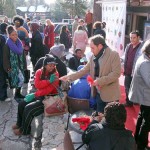With military-honed skill and at great personal risk, Garner Valley resident Ronnie N. Imel delivered the most important Valentine neighbor Kathleen Walker had ever received. He saved her life.
Imel is a modest man and was reluctant to discuss the rescue, saying it felt awkward to call attention to himself. But after several questions, he agreed to describe what happened, noting that anyone would have done what he did.
But fortunately for Walker, Imel was the right person at a perilous moment. And few volunteer rescuers, no matter how well-intentioned, could have accomplished what Imel did.
As with any rapidly unfolding emergency, the difference between success and failure comes down to skill, in-the-moment strategic planning and a cool head. Given the circumstances on that Valentine’s Day morning, Imel’s presence on the scene was critical.
Walker recalled that earlier in the morning of the 14th, she had driven out on Morris Ranch Road toward Highway 74, crossing a small wash at that time. After a trip to Aguanga, she returned home, turning onto Morris Ranch Road. She said she misjudged the depth of water and its speed. When her car stalled and began to drift, with water too high on the driver’s door for her to open it, she called 911.
At the same time, Imel’s wife Sally noticed from the window of her home what was happening to Walker’s car. She roused Ronnie, who was napping on the couch. Now at around 11 a.m., she told him someone was stuck with water going over the road and was in a very difficult position. Imel surveyed the scene and determined that if the car in danger continued to drift it would be carried over a bank and down a 9- to 10-foot drop.
Imel got into his 7,000-pound Dodge 2500 Ram truck. “I first drove through the wash to make sure I could and then turned around to align my passenger side with her driver’s side,” said Imel. “I motioned for her to open her window. After she did, I tried to pull her from her car through her window and into my truck. That didn’t work.”
Imel got out through his rear window and into the water. He struggled against the current to get to Walker. When he reached her, he wrapped his truck’s passenger seatbelt below Walker’s arms and lifted her into his truck.
By now he was beginning to lose his footing in the increasing current. “The current was now rushing faster than one could run alongside of it,” he recalled. “It was starting to push me so that I could not pull myself up. I shimmied along the side of the truck to the back wheel, using it to climb back into the bed of the truck and then through the back window into the cab.”
Imel noted that by this time, Cal Fire had arrived on the other side of what was now, he estimated, a river 100 to 150 yards wide.
Again, with understated modesty, Imel stated, “I’m no stranger to danger. I have military training in helicopters, parachuting, mountain climbing and other areas. I’m not a hero, but this was a dangerous situation most people should not have taken on.”
Walker agreed, but could not understand why, after the fire department first responders arrived, they waited on the other side of the wash and did not attempt to intervene and assist Imel in what was clearly a life-threatening situation. “It was pretty harrowing,” she said, noting that after the rescue, Ronnie and Sally took her into their home, gave her warm clothing and fed her. “They said, ‘Come to our house, we’re going to take care of you.’ Another thing he [Ronnie] did was to get other neighbors to help move my car to the side so it would not be washed away.
“Ronnie is a class act. And I am grateful to live on this mountain where, like Ronnie and Sally, people take care of each other.”
Even though Imel did not tout the depth of his military service, on research, the Crier discovered he had been awarded a Silver Star for service in Vietnam. His citation reads in part, “With complete disregard for his personal safety, Sergeant Imel moved 50 meters through the hostile fire raking the area to mark his position and direct devastating supporting fires upon the enemy which caused the aggressors to flee. His courageous initiative and exemplary professionalism significantly contributed to the successful outcome of the encounter.
“Staff Sergeant Imel’s unquestionable valor while engaged in military operations involving conflict with an insurgent force is in keeping with the finest traditions of the military service and reflects great credit upon himself, the 1st Infantry Division, and the United States Army.”
Imel also maintains a 501(c)(3) organization, Veterans Paying it Forward, the purpose of which is to aid and assist combat veterans.
In response to a query from the Town Crier regarding the incident, Riverside County Fire Department Mountain Battalion Chief Dan Olson explained what appeared to be a policy decision by responding fire personnel to not cross what Olson described as “dynamic water flow.”
Olson noted that not all crews are trained in swift-water rescue nor do all engines carry the necessary equipment for such rescues. Complicating the Valentine’s Day rescue in Garner Valley was the already strained personnel deployment dealing with 19 swift-water emergencies on that day.
Garner Valley Station 53 was already deployed on other emergencies and backup from Station 33 in Palm Desert had been requested. It was personnel and equipment from Station 33 that showed up in answer to Walker’s 911 call. “Crews from 33 had been moved to the mountain in a repositioning staffing decision,” said Olson.
The department has guidelines regarding swift-water rescue requiring intervention only when properly trained crews, helicopters or other equipment can be involved. “It is our policy not to create more victims and, from the picture from the scene, it looks as if the water was flowing in a dynamic and swift way,” explained Olson. “So, if none on the crew were swift-water trained or if they lacked the proper swift-water equipment, then policy would have been to request backup with the proper equipment and training.”
Rescue by private citizen Imel was already in progress and overstrained Cal Fire resources might not have been able to supply required personnel and equipment in time.
Olson is reaching out to Station 33 personnel to get their account. He stressed for motorists to heed signs warning to “Turn Around Not Drown” when they encounter free flowing water on roadways. Speed and depth can be underestimated until it is too late. The department defines “dynamic water flow” as water deeper than 10 inches moving 5 to 6 mph or more, although circumstances can differ location to location.










